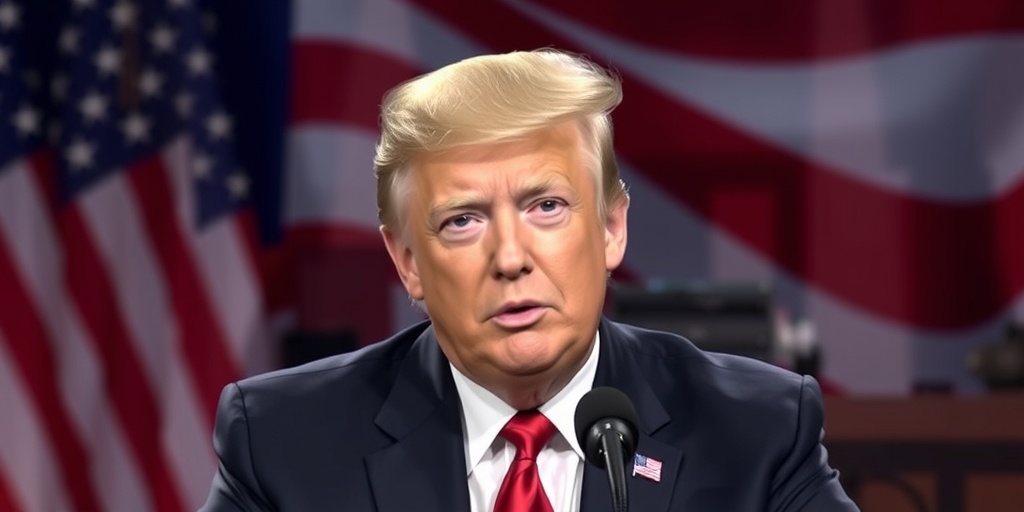Now Reading: Trump’s Tariff Decision: Reasons and Future Implications
-
01
Trump’s Tariff Decision: Reasons and Future Implications
Trump’s Tariff Decision: Reasons and Future Implications

President Trump Unveils Controversial New Tariff Policy: A Move Towards Economic Change
In a significant announcement on Wednesday, President Trump outlined a sweeping overhaul of the United States’ import tax system that could reshape the country’s economic landscape for years to come. This new tariff initiative replaces America’s traditional methods of taxing imports with a more aggressive and self-designed tariff framework.
During a press conference, President Trump articulated his belief that the newly implemented tariffs would remedy what he deemed decades of unfair economic practices by other nations. "The markets are going to boom, and the country is going to boom," he declared, despite the reality of global financial markets experiencing their largest downturn in recent memory. He accused foreign nations of having "taken advantage of us for many, many years," suggesting that his tariff strategy would encourage the relocation of manufacturing jobs back to American soil.
While Trump expressed a visionary outlook regarding the potential economic benefits, most economists view this shift with skepticism. Predictions indicate that the newly established tariffs and the inevitable retaliatory measures from other nations could lead to a slowdown in U.S. economic growth, increased costs for consumers, and challenges for businesses reliant on international supply chains.
Understanding the New Tariff System
The president’s tariff regime consists of two primary components that apply to a broad spectrum of imports. The first is a “base line” tariff of 10 percent, imposed on nearly all imports, with exceptions made specifically for goods from Canada and Mexico. The second component introduces what Trump calls a “reciprocal” tariff system. This will apply to 57 countries that the administration claims maintain high tariffs and engage in practices detrimental to American exporting interests. The reciprocal tariffs aim to mirror how these countries treat American imports.
Interestingly, the rates assigned to these reciprocal tariffs are not directly correlated with the existing tariffs of other nations. Instead, they are based on the United States’ trade deficit with each country, which measures the gap between American exports and imports. The tariffs will range from 1 percent to an astonishing 40 percent in addition to the base line tariff.
The base tariffs are slated to take effect on Saturday, with the reciprocal tariffs set to follow on Wednesday of the following week.
Countries Facing the Highest Tariffs
The nations most impacted by Trump’s tariffs include major trading partners such as China, Japan, Germany, India, South Korea, Taiwan, and Vietnam. Notably, Canada and Mexico are exempt from this tariff enforcement, largely because of previous tariffs applied to them and the trade agreement formed in 2020, known as the United States-Mexico-Canada Agreement (USMCA).
In stark contrast, goods arriving from Europe will now be subjected to a 20 percent tariff, while Japanese imports will incur a 24 percent tariff and those from South Korea a 26 percent tariff. Products imported from China will face an additional 34 percent tariff, compounding the already imposed 20 percent tariffs, resulting in tariffs as high as 79 percent for some goods. Furthermore, as many manufacturers shifted operations to Vietnam post-2018, a new tariff of 46 percent has now been announced for commodities imported from there, while similar products from Cambodia will be taxed at an exorbitant 49 percent.
Interestingly, the president decided against imposing tariffs on Russia, North Korea, Cuba, and Belarus, stating that these countries are already hindered by existing sanctions. However, imports from Russia amount to $3 billion annually, a figure that starkly contrasts with smaller nations targeted by the new tariffs.
Objectives Behind the Tariff Scheme
The administration’s objective is clear: to compel companies to produce within the United States by making foreign production cost-prohibitive. The president asserts that such a measure will lead to job creation and wage increases among American workers. “If you want your tariff rate to be zero,” Trump stated, “then you build your product right here in America.”
Nevertheless, uncertainty looms regarding whether these tariffs are intended as a formidable negotiating tool, potentially allowing for their removal in exchange for favorable trade terms from other countries. Mixed signals from the administration suggest that while the base tariff is unlikely to be lifted, there may be room for negotiation on the reciprocal tariffs.
Impact on the U.S. Economy
Economic analysts are already revising their forecasts in light of the tariff announcement, predicting inflationary pressures that will affect consumer purchasing power as well as business operating expenses. Following similar patterns observed during previous tariff impositions, the expectation is a pass-through of costs to consumers, leading to increased prices on goods like apparel, electronics, and everyday items.
With estimates suggesting that U.S. households could incur an additional $2,100 annually in costs due to the new tariffs, the impact on lower-income families is especially concerning. The aggregation of tariffs could increase national tariff revenue to upwards of $1 trillion, significantly surpassing the previous year’s total of $78 billion.
In conclusion, President Trump’s new tariff policies have sparked a complex landscape of economic implications that may affect international relations and reshape the domestic market. With many uncertainties looming, economists caution that the potential benefits outlined by the administration could be overshadowed by broader economic repercussions, including a heightened risk of recession and diminishing corporate profits.
Stay Informed With the Latest & Most Important News
Previous Post
Next Post
-
 01New technology breakthrough has everyone talking right now
01New technology breakthrough has everyone talking right now -
 02Unbelievable life hack everyone needs to try today
02Unbelievable life hack everyone needs to try today -
 03Fascinating discovery found buried deep beneath the ocean
03Fascinating discovery found buried deep beneath the ocean -
 04Man invents genius device that solves everyday problems
04Man invents genius device that solves everyday problems -
 05Shocking discovery that changes what we know forever
05Shocking discovery that changes what we know forever -
 06Internet goes wild over celebrity’s unexpected fashion choice
06Internet goes wild over celebrity’s unexpected fashion choice -
 07Rare animal sighting stuns scientists and wildlife lovers
07Rare animal sighting stuns scientists and wildlife lovers





















